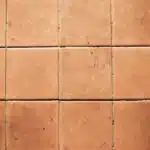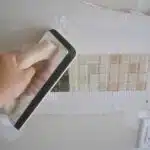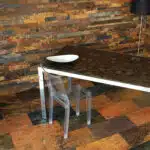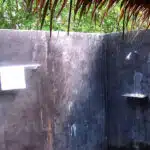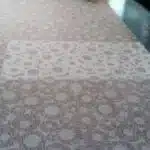Shower tiles are an essential part of any bathroom, providing both functionality and aesthetics to the space. However, over time, these tiles can suffer from wear and tear, resulting in cracks, chips, and general damage. This damage can not only be unsightly but can also lead to water leakage and further deterioration of the shower area. Therefore, it is crucial to understand how to repair shower tiles effectively.
In this article, we will discuss the different types of shower tile damage you may encounter and provide step-by-step instructions on how to repair them. From minor repairs such as filling in cracks with caulk or epoxy to more extensive repairs such as replacing broken tiles or fixing leaking grout lines, we will cover all aspects of shower tile repair. With this knowledge, you will be able to tackle any tile repair project with confidence and ensure that your bathroom remains functional and visually appealing for years to come.
Understanding The Importance Of Shower Tile Maintenance
Shower tile maintenance is essential to ensure the longevity and functionality of your bathroom. The importance of shower tile maintenance cannot be overstated, as it can save you from costly repairs in the future. Proper care and maintenance of shower tiles not only keep them looking new but also prevent water damage, mold growth, and other types of deterioration.
Neglecting shower tile maintenance can lead to an array of problems that could have been prevented with proper upkeep. The cost of neglecting shower tile maintenance can be high, as it may result in the need for expensive repairs or even replacement. A lack of regular cleaning can cause soap scum buildup that corrodes grout lines and tiles over time. As a result, water may seep behind the tiles, which can lead to mildew growth and structural damage.
Therefore, understanding the importance of shower tile maintenance is crucial for any homeowner or tenant who wants to keep their bathroom functional and beautiful. By incorporating simple habits such as regular cleaning and sealing, you can prevent common types of damage and extend the life expectancy of your shower tiles. In the next section, we will delve into identifying common types of shower tile damage so that you can take appropriate action when necessary.
Identifying Common Types Of Shower Tile Damage
As we have discussed earlier, shower tile maintenance is an essential aspect of keeping your bathroom in good condition. Neglecting the upkeep of your shower tiles can lead to an array of problems, including discoloration and mold growth. It is crucial to understand the common types of damage that can occur and how to identify them.
One type of damage that you may encounter is discoloration on your shower tiles. This can occur due to a variety of reasons, such as hard water stains or soap scum buildup. Repairing shower tile discoloration requires the use of specific cleaning solutions and techniques that are gentle yet effective in removing stains without damaging the tiles.
Another common issue with shower tiles is mold growth. Mold thrives in damp environments, making bathrooms an ideal breeding ground for it. To prevent shower tile mold growth, it is necessary to keep your bathroom dry, well-ventilated, and clean. If you notice any signs of mold on your tiles, it’s crucial to take immediate action and remove it using a suitable cleaning solution.
To repair damaged shower tiles effectively, gathering the necessary tools and materials is essential. You will need a grout saw or scraper to remove damaged grout or caulk from between the tiles, replacement grout or caulk, a putty knife or trowel for applying new grout or caulk, and sandpaper for smoothing out any rough edges after repairs are complete. By having these tools readily available before starting any repairs, you can ensure a seamless process that yields satisfying results.
Gathering The Necessary Tools And Materials
When repairing shower tiles, the first step is to purchase the necessary materials. This includes tiles, tile adhesive, grout, sealant, a tile saw, and other necessary tools.
The tile saw is the most critical tool needed to make the necessary cuts in the tiles. It is important to select one that is appropriate for the material and job that needs to be done.
Other important tools to have when repairing shower tiles include a notched trowel, a rubber float, a sponge, and a grout saw.
It is also necessary to have a bucket of clean water, a putty knife, a drill and drill bit, an electric jigsaw, and a utility knife for cutting the tiles.
Purchasing Materials
When it comes to repairing shower tiles, one of the first steps is gathering the necessary tools and materials. Purchasing materials is an essential aspect of this process, as having the right supplies can make all the difference in a successful tile repair. One important factor to consider is comparing prices among different stores or suppliers. This can help ensure that you are getting the best value for your money.
In addition to comparing prices, it may also be beneficial to find alternatives to certain materials. For example, if a specific type of tile adhesive is out of stock or too expensive, there may be other options that work just as well. It can be helpful to do some research and ask for advice from professionals in the field. This not only saves money but also allows for greater flexibility in terms of choosing materials that best suit your needs.
Ultimately, purchasing materials for shower tile repair requires careful consideration and attention to detail. By taking the time to compare prices and explore alternative options, you can ensure that you have everything you need for a successful repair project. With proper planning and preparation, you can tackle any tile repair job with confidence and ease.
Gathering Tools
Choosing the right tools is an essential aspect of any home improvement project, including repairing shower tiles. With the right tools at hand, homeowners can ensure that they complete the job quickly and efficiently. The first step in gathering tools for shower tile repair is to assess the extent of the damage. This will help determine which tools are necessary for the repair.
Once you have assessed what tools are necessary, it’s time to find where to buy them. Home improvement stores, hardware stores, and online retailers offer a wide range of options when it comes to purchasing tools for shower tile repair. When deciding which store to purchase from, consider factors such as price, quality, and availability of specific items. It may also be helpful to ask for recommendations from professionals in the field.
In addition to choosing where to buy necessary tools, it’s important to prioritize safety when handling these tools during a shower tile repair project. Always wear appropriate safety gear such as gloves and eye protection when using power tools or sharp objects. By taking proper precautions and investing in high-quality tools, homeowners can tackle any shower tile repair project with confidence and ease.
Preparing The Damaged Area For Repair
Techniques for preparation are crucial to ensure the success of repairing shower tiles. The first step in preparing the damaged area is to remove any loose or chipped tiles using a grout saw or a utility knife. This will provide a clean surface for the new tile adhesive to bond securely.
The next step is to clean the area thoroughly with a mixture of warm water and soap. Make sure that there is no dirt, grime, or soap residue left behind as they may hinder the bonding process. Rinse the area with clean water and let it dry completely before proceeding to the next step.
Common mistakes to avoid in this stage include failing to remove all loose tiles, not cleaning the area properly, and not letting it dry completely before starting with repairs. Skipping any of these steps can lead to improper bonding of new tiles, which can cause more damage in the long run. Taking time and patience during this stage will ensure that your repair work is successful and durable.
Moving on from preparing the damaged area, we now proceed to filling in minor cracks with caulk.
Filling In Minor Cracks With Caulk
- In order to repair shower tiles, the surface must be properly prepared to ensure a successful application of caulk.
- This includes cleaning the surface with a mild soap and water solution, rinsing, and drying thoroughly.
- Once the surface is dry, it is important to use a caulking gun to apply the caulk to the cracks in a uniform manner.
- The caulk must then be smoothed out with a wet finger or a damp cloth to ensure a seamless finish.
Preparing The Surface
Are you planning to repair your shower tiles? One of the most crucial steps in tile repair is surface preparation. Without proper preparation, any attempt to repair minor cracks with caulk will be futile. Surface preparation involves cleaning the area around the damaged tiles and removing any loose grout or debris. This step ensures that the new caulk adheres well to the surface.
To prepare the surface, you will need some necessary tools such as a scraper, a utility knife, and sandpaper. The scraper and utility knife will help you remove any loose grout or debris while the sandpaper is essential for smoothing rough surfaces. Once you have cleaned and sanded the area, use a damp cloth to wipe off any residual dust or debris.
Proper surface preparation sets the foundation for successful tile repair. Skipping this step will only lead to frustration and wasted time. So before filling in minor cracks with caulk, ensure that you have done a thorough job of preparing the surface using the necessary tools.
Applying The Caulk
Now that the surface preparation has been taken care of, it is time to apply the caulk. Caulk is a flexible material used to seal gaps and cracks between two surfaces. It creates a waterproof barrier that prevents water from seeping through the cracks. Applying caulk requires some techniques and tips to ensure a smooth and even finish.
One of the most critical tips when applying caulk is to choose the right type of caulk for your tile repair project. There are different types of caulks available in the market, such as silicone, latex, and acrylic. Each type has its unique properties and is suitable for specific applications. For instance, silicone caulks are ideal for areas exposed to water and moisture, while acrylic caulks are better suited for indoor applications.
Another essential technique when applying caulk is to use a caulking gun instead of applying it manually using your fingers. A caulking gun ensures that the caulk is applied evenly and smoothly without any mess or waste. To begin, cut off the tip of the caulk tube at an angle using a utility knife. Insert the tube into the caulking gun and apply steady pressure on the trigger while moving it along the crack in one continuous motion.
By following these techniques and tips when applying caulk, you can achieve professional-looking results with ease. Remember always to work carefully and take your time when filling in minor cracks with caulk to ensure long-lasting repairs that will serve you well over time.
Using Epoxy To Fill In Larger Cracks And Chips
To achieve a seamless repair, using epoxy to fill in larger cracks and chips is the way to go. Epoxy is a type of resin that hardens when mixed with a hardener. It creates an incredibly strong bond that can withstand water exposure and extreme temperatures.
When applying epoxy, it’s essential to follow proper techniques to ensure optimal results. First, clean the damaged area thoroughly and allow it to dry completely. Then, mix the epoxy and hardener according to the manufacturer’s instructions. Apply the mixture with a putty knife or small spatula, making sure it fills in all cracks and chips evenly. Once applied, let it dry for at least 24 hours before sanding down any excess epoxy.
Color matching epoxy filler is also important for achieving a professional-looking repair job. Many manufacturers offer various colors of epoxy filler that can match most tile colors accurately. If you cannot find an exact match, blending two different shades can create a custom color that matches more closely. With proper application and color matching techniques, your shower tiles will look brand new once again.
Now that you know about using epoxy to fill in larger cracks and chips successfully let’s move on to replacing a single damaged tile without disrupting the surrounding tiles’ integrity.
Replacing A Single Damaged Tile
After filling in the larger cracks and chips with epoxy, it’s time to assess the damage of your shower tiles. If there is a single damaged tile that needs replacing, you’ll need to find a matching one first. This can be done by checking with the original manufacturer or looking for similar tiles at a home improvement store. Once you have a replacement tile, it’s time to cut and install it.
Cutting the new tile will require some precision to ensure a proper fit. Measure the size of the damaged tile and use those measurements to mark where you need to make cuts on the new tile. Use a wet saw or tile cutter to make those cuts before removing any excess material with sandpaper. Once the new tile has been cut, apply adhesive on its backside and press it firmly into place. Allow the adhesive to dry completely before using your shower again.
When dealing with multiple damaged tiles, the process is similar but more time-consuming. You’ll need to repeat the steps above for each individual damaged tile until all have been replaced. It’s essential that you take your time during this process and ensure that each new tile is level and properly aligned with surrounding tiles. In doing so, you’ll be able to restore your shower tiles back to their original condition without any noticeable differences between old and new tiles.
Removing And Replacing Multiple Damaged Tiles
To remove and replace multiple damaged tiles in a shower, you will need to follow specific steps. Firstly, you should gather all necessary equipment such as a chisel, hammer, tile adhesive, grout, and replacement tiles. Secondly, use the chisel to gently chip away at the damaged tiles and remove them completely from the wall. It is important to ensure that all debris is removed from the area before proceeding.
Matching tile replacement can be difficult but not impossible. The easiest way to find matching tiles is by contacting the manufacturer or supplier of your original tiles. If this is not possible, bring a sample of your original tile to your local hardware store or home improvement center. They may have similar styles in stock or be able to order them for you if they are still being produced. Dealing with uneven surfaces can also be a challenge when replacing multiple tiles. Use a leveling compound on any areas that are not flat before applying adhesive and setting new tiles in place.
With these tips in mind, removing and replacing multiple damaged shower tiles should be relatively straightforward. However, if you encounter issues such as loose or hollow tiles during the process, it may require additional steps to ensure proper installation. In the next section, we will cover how to fix loose or hollow tiles in your shower for a complete repair job.
Fixing Loose Or Hollow Tiles
As a home improvement specialist, I understand the frustration that comes with loose or hollow tiles in your shower. It not only affects the aesthetics of your bathroom but also poses a safety hazard. To fix this issue, finding solutions to the root cause is vital.
Firstly, it’s essential to locate and identify the problem area. Loose or hollow tiles can be caused due to various factors like water damage, inadequate adhesive application, or substrate issues. Once you have pinpointed the exact location and reason for the problem, you can proceed with fixing it appropriately.
Preventing recurrence is equally crucial as fixing the current issue. For instance, if water damage was the cause of loose tiles, waterproofing the substrate before installing new tiles can prevent future occurrences. Similarly, using high-quality adhesive and ensuring proper installation techniques will significantly reduce any chances of hollow tiles.
In summary, fixing loose or hollow tiles in a shower involves identifying and locating the problem area and addressing it accordingly while implementing preventive measures to avoid recurrence. In the next section on repairing leaking grout lines, we’ll discuss how to tackle another common issue faced by homeowners in their bathrooms.
Repairing Leaking Grout Lines
A common problem with shower tiles is leaking grout lines. If you notice water damage or mold growth, it’s likely that water is seeping through the grout lines and damaging the surrounding area. Repairing leaking grout lines can prevent further water damage and keep your shower looking great for years to come.
The first step in repairing leaking grout lines is to remove any damaged or missing tiles. This will allow you to get a better look at the underlying cause of the leak. Once you’ve removed the tiles, inspect the area for any cracks or holes in the grout lines that may be allowing water to seep through. Use a waterproof sealant to fill these gaps and prevent future leaks.
If your shower has suffered from water damage due to leaking grout lines, it’s important to address the problem as soon as possible. Water damage can lead to mold growth and structural problems that can be costly to repair. By repairing missing tiles and preventing future leaks, you can ensure that your shower remains in good condition for years to come.
To prevent future damage, it’s important to clean and seal your grout regularly. In the subsequent section, we’ll discuss how to properly clean and seal your grout using simple techniques that can help prevent moisture from penetrating your shower walls and floors. By taking simple steps like these, you can protect your home from potential water damage caused by leaking shower tiles.
Cleaning And Sealing Grout To Prevent Future Damage
Grout cleaning tips are essential to prevent future damage on your shower tiles. It is crucial to clean the grout regularly, especially in areas with high moisture and humidity levels. You can use a mixture of vinegar and baking soda for natural cleaning or opt for commercial-grade cleaners that are specifically designed to clean grout.
Choosing sealant products is also critical when it comes to preventing shower tile damage. Sealants protect the grout from moisture, stains, and bacteria, making it more durable and longer-lasting. There are various types of sealant products available in the market, such as water-based or solvent-based sealers. Make sure to choose a sealer that suits your specific needs and requirements.
Regular maintenance is key in preventing shower tile damage. Besides cleaning the grout and using sealant products, you should also inspect your tiles for cracks or leaks regularly. Ensure that your bathroom has proper ventilation to reduce humidity levels and prevent mold growth. By implementing these preventative measures, you can extend the lifespan of your shower tiles and save money on costly repairs in the future.
Transition: While regular maintenance can help prevent shower tile damage, accidents can still happen. In the subsequent section, we will discuss how to repair minor damages on your shower tiles quickly and efficiently without causing further harm or damage.
Preventing Shower Tile Damage With Regular Maintenance
With regular cleaning and sealing, you can prevent future damage to your shower tiles. Protective coatings can help prolong the life of your tiles by providing an extra layer of defense against water, soap scum, and mildew. To ensure that your shower remains in top condition, it is important to take proactive steps towards maintaining its integrity.
Here are four tips for preventing shower tile damage with regular maintenance:
- Clean your shower regularly to remove any buildup of soap scum or mold.
- Use protective coatings on your tiles to prevent moisture penetration.
- Keep a squeegee handy and use it after each shower to remove excess water from the tiles.
- Check for any signs of damage or wear and tear, such as cracks or loose tiles, and address them promptly.
By following these simple guidelines, you can keep your shower looking great for years to come. However, if you notice any complex issues with your shower tiles that require professional attention, hiring a specialist may be necessary. With their expertise and tools at hand, they can diagnose the problem quickly and efficiently and provide a long-lasting solution that will protect your investment in the long run.
Hiring A Professional For Complex Repairs
When it comes to complex shower tile repairs, it may be best to consider hiring a professional. While DIY options can be tempting, they may not always yield the results you desire. A professional can provide expertise in identifying and addressing underlying issues that may be causing tile damage.
Researching reputable contractors is an important step in finding the right professional for your shower tile repair needs. Look for contractors with experience in bathroom renovations and tile work. Don’t hesitate to ask for references or view their portfolio of past projects.
While hiring a professional may require an upfront cost, it can save you money in the long run by avoiding potential mistakes or further damage caused by inexperienced DIY attempts. Additionally, a professional can offer advice on budget-friendly options for repairing your shower tiles without sacrificing quality.
Transition: Now that you’ve considered hiring a professional for your shower tile repairs, it’s important to also consider budgeting for the project.
Budgeting For Shower Tile Repairs
When it comes to repairing shower tiles, the cost can add up quickly. It’s important to budget for the repairs and consider whether or not you want to take on the project yourself or hire a professional. The decision between DIY vs professional depends on your level of expertise and comfort with home improvement projects.
If you decide to tackle the repairs yourself, there are cost-saving tips you can follow. First, research and purchase high-quality materials that will last longer and require fewer replacements in the future. Second, borrow or rent tools from friends or local hardware stores instead of buying them outright. Third, watch online tutorials or read instructional books before starting the project to avoid mistakes that could lead to more expenses.
Hiring a professional may seem like a more expensive option, but it can actually save you money in the long run. Professionals have access to better quality materials at discounted prices and are trained to complete the job correctly without causing damage that could result in even more costly repairs down the line. Additionally, hiring a professional can save time and effort that could be spent on other tasks around your home.
Maintaining the aesthetics of your bathroom during repairs is important for both DIY and professional options. Consider using temporary coverings such as plastic sheets or tarps to protect surrounding areas from dust and debris. Also, be mindful of color matching when replacing tiles to ensure a cohesive look in your bathroom once repairs are complete.
Maintaining The Aesthetics Of Your Bathroom During Repairs
It is a common belief that bathroom repairs always result in a messy and unsightly space. However, with the right approach, you can maintain the aesthetics of your bathroom during repairs. One of the ways to achieve this is through temporary shower tile cover ups. These are available in different colors and designs, allowing you to choose one that matches your current tiles. When installing them, ensure that they are applied evenly to avoid any bumps or bubbles.
While DIY repairs may seem like an attractive option due to their cost-effectiveness, they may not always guarantee optimal results. Bathroom repairs require specialized skills and tools for proper installation and maintenance. Hiring a professional plumber or home improvement specialist can help you achieve a seamless and aesthetically pleasing finish. They have the necessary expertise to assess the extent of damage and recommend appropriate solutions.
In conclusion, maintaining the aesthetics of your bathroom during repairs requires careful planning and execution. Tips such as using temporary shower tile cover-ups can go a long way in ensuring a clean and attractive space while waiting for permanent solutions. While DIY options may seem appealing, seeking professional help guarantees better results in terms of functionality and aesthetics. Therefore, it is crucial to consider hiring a specialist when making any significant bathroom renovations or repairs.
Conclusion
Proper shower tile maintenance is important for the longevity and overall appearance of your bathroom. Identifying common types of damage such as cracks, chips, and mold can help you address the issue before it worsens. To repair minor damage, gather the necessary tools and materials such as caulk and grout.
Before beginning repairs, prepare the damaged area by cleaning it thoroughly and removing any loose tiles or debris. Apply caulk to fill in minor cracks, but for complex repairs or extensive damage, hiring a professional may be necessary. Budgeting for shower tile repairs can also help ensure that you are financially prepared for unexpected damages.
Maintaining the aesthetics of your bathroom during repairs is essential to avoid further damage. Regular maintenance such as cleaning and sealing can also prevent future issues from occurring. As a home improvement/plumbing specialist, always remember to prioritize safety and consult with professionals when necessary.
In conclusion, taking care of your shower tiles is crucial to maintain the overall quality of your bathroom. By identifying common types of damage, gathering necessary tools and materials, preparing the damaged area for repair, filling in minor cracks with caulk, preventing future damage with regular maintenance, budgeting for repairs, and maintaining aesthetics during repairs, you can ensure that your bathroom remains in pristine condition. So why wait? Start taking care of your shower tiles today!
Image Credits
- “Travertine tile around tub and shower” by Sitka Projects LLC (featured)




